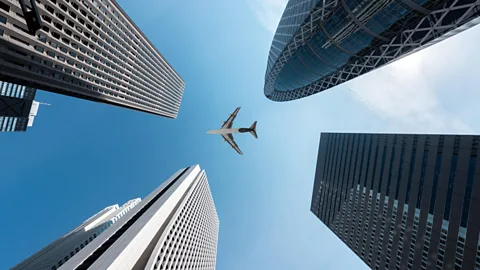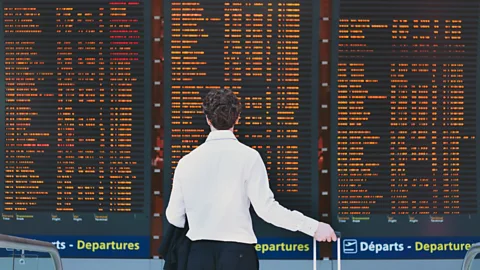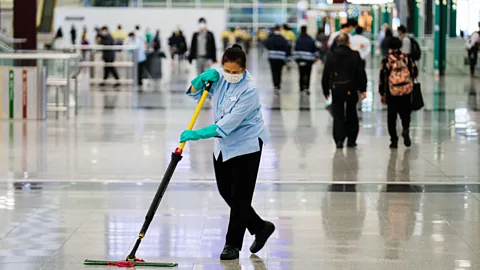Will business travel ever be the same?

Covid-19 has grounded business travellers. When the world opens back up, will employees close down Zoom and get back on planes?
When most of us aren’t even travelling to the office, going on a business trip feels about as remote as taking the red-eye to Mars.
Since the Covid-19 pandemic hit, business travel has ground to a halt. We’ve moved critical client meetings to Zoom, allowed our frequent-flier cards to gather dust and learned how to communicate with colleagues around the world without jumping on a plane.
But is this the start of a new normal for business travel? BBC Worklife spoke to Charuta Fadnis, senior vice-president of research at travel analytics firm Phocuswright; Dave Hilfman, the executive director of the Global Business Travel Association (GBTA); and Susan Liechtenstein, managing partner at US-based consultancy firm DigiTravel, to hear what might be in store.
When will business travel restart?
Among the unknowns around a vaccine, how quickly economic recovery sets in and how soon countries roll back border restrictions, travel experts face many unanswerable questions.
“We’re all struggling a little bit to understand how quickly travel will recover, because there's just no precedent to something like the coronavirus pandemic,” says Fadnis. Recovery from past events like 9/11 or the global financial crisis generally took two to three years, but these events also did not entail the same months-long shutdown of virtually all global travel. Health concerns were not an issue in either event, making it even harder to predict how soon fliers may feel comfortable exposing themselves to strangers once again. “This crisis is really new, in terms of the magnitude of the impact,” she says.
In a July survey of more than 2,000 GBTA members, 44% said they expected domestic business travel within the US to resume in the next two to three months. Around a third pegged it at six to eight months, while 15% said they simply didn’t know.
 Alamy
AlamyInternational travel is a harder proposition, says Fadnis, particularly “a more smooth travel experience where countries open up their borders and allow a seamless flow”. Airlines such as Australian national carrier Qantas have suspended all international flights, while border closures have prevented the majority of travellers from moving freely around the world. There’s a world of difference between hopping on a Eurostar from Paris to London – already a possibility – and a long-haul flight from Sydney to Dubai or across the Atlantic. New travel corridors, such as the ones suggested between Vietnam and South Korea or New Zealand and Australia, may support some regional business travel.
Does anyone even want to travel for work?
While Zoom might replicate much of the experience of an in-person chat, for many businesspeople there’s nothing quite like seeing clients in person, especially when building relationships, hashing out the finer details of a sensitive deal or understanding how a business works from the inside. Even a simple handshake helps us to create bonds: a 2008 study from the University of Iowa found that the gesture helped release oxytocin in the brain, in turn building trust between strangers and helping to sustain co-operation.
More than that, it often makes financial sense to invest in sending workers around the world: one study, by forecasting firm Oxford Economics, found that every dollar spent on business travel resulted in $12.50 in incremental revenue.
“People getting together face-to-face is the only way, really, to achieve ultimate success in business,” says Hilfman. “Many of my colleagues in the industry, be it on the corporate side, the travel side or supply side, they’re very anxious to get back out on the road again and see their customers and colleagues.”
Business travel can provide the chance to network, see the world and take advantage of fantastic personal development opportunities. But for every person itching to hit the tarmac, there are many others who may be concerned about the risk to their health or simply glad to avoid the stress of international travel. Already, European travellers have swapped planes for trains, particularly those that offer a sleeper service with individual cabins. In the US, early indicators suggest that customers aren’t returning to flying as quickly as airlines would like, or expect. The industry group IATA now believes travel will not return to pre-pandemic levels before 2024.
Still, for many businesses, what the customer wants will be the deciding factor, says Liechtenstein: “The biggest customers that you have, if they want to have a face-to-face: will you go? Of course you’ll go.” Until those customers are prepared to brave the risks, it’s not worth companies’ while to push it, especially while the majority of employees seem so disinclined to put themselves in close proximity to the flying public.
In many cases, the health risks may not be as great as they appear. Flying seems to have lower transmission rates than inside dining or religious services, among other ‘risky’ activities, due to a combination of hospital-grade air filters and the dryness of cabin air. But concerns about being in close proximity to strangers, fellow passengers not wearing masks and general discomfort around flying have together led many to rule it out.
 Alamy
AlamyThat said, there are reasons beyond the immediate health risks to curb business travel. Technological solutions including video-conferencing and workplace chat platform Slack have helped bolster communication between geographically-distant workers, eliminating some of the need for expensive travel. Even investment bankers, long used to late evenings in the office or travelling at the drop of a hat, are embracing at-home alternatives.
There’s a financial upside, too. As a looming global recession threatens to squeeze business travel budgets for some time, the standard for what does and doesn’t warrant a trip is all but certain to change. In an April earnings call, Deutsche Bank CEO Christian Sewing spoke enthusiastically about the possibility of cutting both real estate and travel costs via more remote work. “We will change the way we are working, absolutely,” he said. “We even have further ammunition actually to reduce our costs.”
Environmental concerns are yet another reason to stay grounded. While aviation actually only contributes about 2% of global emissions, it’s a pressing issue as an industry that’s particularly hard to decarbonise. Nearly half of UK workers worry about the negative environmental impact of business travel, according to a June survey from O2’s Business division.
What will the next iteration of business travel look like?
Since 2017, global business travel spending has exceeded $1.3tn each year, with China and the US the two largest markets at more than $290bn each. But it could be years before the sector recovers to the same point, if ever.
“I think business travel will never go back to what it was before, when people easily said, ‘I'm going to meet with somebody,’ got on a plane, and did that, without thinking through what the actual meeting was,” says Liechtenstein. She anticipates that demand might return to about 75% of 2018 levels by 2022.
In the long run, she says, business travellers may be expected to combine multiple meetings into one trip, especially given the likely increase in the cost of travel. Better safety and cleaning protocols will likely contribute to higher prices, especially if deep cleaning planes requires more time on the tarmac between flights. After an initial price shock, fares could rise by as much as 54%, according to estimates from airline industry group IATA.
Some hope that this reset could actually improve business travel, both from a health and safety perspective, and in terms of the actual mechanisms of air travel infrastructure. “Business travel is going to go through an evolution here and it is being reshaped, I think for the better,” says Hilfman. Customers will likely get used to flying on squeaky-clean planes via spotless airport terminals, or accessing rental cars at any time of the day or night through contactless solutions, he says, with many of these changes also benefiting the leisure travel sector.
For the upper echelons of the tech and business world, private planes have long been part of the equation, with about 13% of S&P500 companies either owning or using a private jet. While in a pandemic context, they might seem a sensible way to impose social distancing or limit potentially risky contact, it’s hardly a workable financial solution for the majority of businesses. “If it’s the CEO of a tech company, sure thing -- and that happens already, today. But if it’s a team going to a conference? I very much doubt that a company's going to shell out for a private jet,” says Fadnis.
